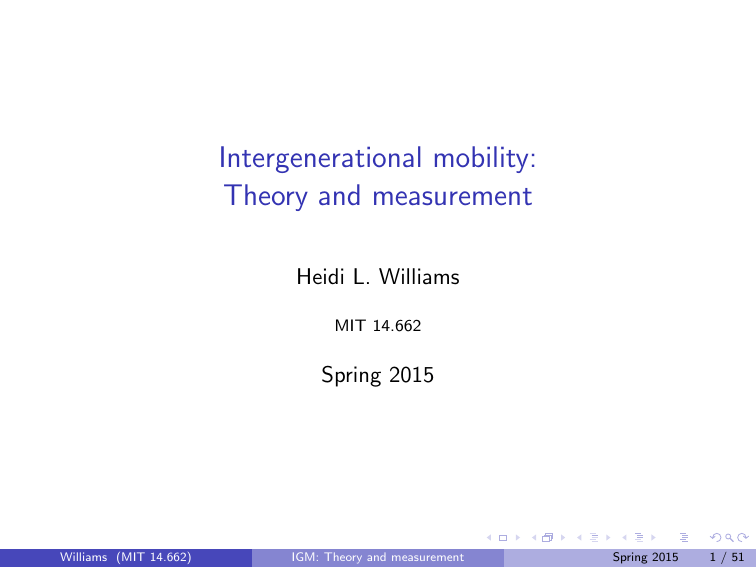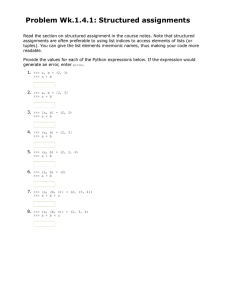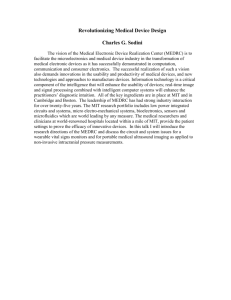
Intergenerational mobility:
Theory and measurement
Heidi L. Williams
MIT 14.662
Spring 2015
Williams (MIT 14.662)
IGM: Theory and measurement
Spring 2015
1 / 51
Intergenerational mobility
Inequality in the distributions of earnings, income, and wealth
Economists long paid more attention to inequality within generations
than inequality within families across generations
Latter more of a focus of sociologists:
Blau-Duncan (1967) The American Occupational Structure
Williams (MIT 14.662)
IGM: Theory and measurement
Spring 2015
2 / 51
Blau-Duncan (1967) The American Occupational Structure
Enormous impact on the field of sociology
Focused on social stratification and
occupational mobility
Other “must read” if you are interested:
Featherman and Hauser (1978)
Opportunity and Change
Williams (MIT 14.662)
IGM: Theory and measurement
Spring 2015
3 / 51
Thought experiment
Solon’s 1999 chapter in the Handbook of Labor Economics:
“Imagine two societies: society A and society B. The distribution of earnings is identical in the
two societies, so in a within-generation sense the two societies are “equally unequal.” But now
suppose that in society A, one’s relative position in the earnings distribution is exactly inherited
from one’s parents: if your parents were in the 90th percentile of earnings in their generation it
is certain that you place in the 90th percentile of your own generation; if your parents were in
the 5th percentile in their generation you inevitably place in the 5th percentile. In contrast, in
society B one’s relative position in the earnings distribution is completely independent of the
position of one’s parents: the offspring of parents in the 5th percentile and the offspring of
parents in the 90th percentile show the same distribution of earnings.”
Williams (MIT 14.662)
IGM: Theory and measurement
Spring 2015
4 / 51
Public concern over (in)-equality of opportunity
DeParle, Jason. "Harder for Americans to Rise From Lower Rungs."
The New York Times. January 4, 2012.
Williams (MIT 14.662)
IGM: Theory and measurement
Spring 2015
5 / 51
NYTimes: Jantti et al. (2006)
Source: Jantti et al. (2006), IZA Discussion Paper #1938
© The New York Times. All rights reserved. This content is excluded from our Creative
Commons license. For more information, see http://ocw.mit.edu/help/faq-fair-use/.
Williams (MIT 14.662)
IGM: Theory and measurement
Spring 2015
6 / 51
Motivation
What (empirically) is the degree of intergenerational mobility?
What (if anything) should be done from a policy perspective?
Sources of intergenerational correlation matter for policy
Williams (MIT 14.662)
IGM: Theory and measurement
Spring 2015
7 / 51
Roadmap for this week
Handbook chapters: Solon (1999), Black and Devereux (2011)
Theory:
�
�
Human capital approach: Becker and Tomes (1979)
Goldberger (1989) critique
Measurement: estimation of intergenerational mobility
�
�
Multi-year averages: Solon (1992), Mazumder (2005)
Lifecycle bias: Haider and Solon (2006)
Empirics: causal mechanisms and within-US variation
�
�
�
Sacerdote (2007) and Björkland et al. (2006)
Black et al. (2005)
Chetty et al. (2014)
Williams (MIT 14.662)
IGM: Theory and measurement
Spring 2015
8 / 51
Recent focus of amazing research in economic history
Not my focus this week, but definitely worth reading:
Long-Ferrie (2013) “Intergenerational occupational mobility in Britain
and the US since 1850”
�
I
I
�
Longitudinal data on 23,000 father-son pairs
Find US was indeed ‘exceptional’ (more mobile) through 1900, but that
this advantage was erased by 1950
Clark (2014) and Clark-Cummins (2012) “Are there ruling classes?
Surnames and social mobility in England, 1800-2011”
I
�
I
�
I
�
Use rare surnames
Track wealth, education, occupation, age at death
Find lower mobility than conventionally estimated
Williams (MIT 14.662)
IGM: Theory and measurement
Spring 2015
9 / 51
Clark-Cummins sources
Williams (MIT 14.662)
IGM: Theory and measurement
Spring 2015
10 / 51
Clark-Cummins sources
http://www.dur.ac.uk/directory/
http://www.ox.ac.uk/applications/contact_search/
http://www.imperial.ac.uk/collegedirectory/
http://jackdaw.cam.ac.uk/mailsearch/
Williams (MIT 14.662)
IGM: Theory and measurement
Spring 2015
11 / 51
Clark-Cummins sources
http://www.nationalarchives.gov.uk/help-with-your-research/research-guides/census-records/
www.gmc-uk.org/doctors/register/lrmp.asp
http://www.houseprices.co.uk
http://www.taliesinarlein.net/names/search.php
http://www.lawsociety.org.uk
http://www.legalhub.co.uk
Williams (MIT 14.662)
IGM: Theory and measurement
Spring 2015
12 / 51
1
Theory
2
Measurement
3
Empirics
4
Looking ahead
Williams (MIT 14.662)
IGM: Theory and measurement
Spring 2015
13 / 51
Theory
Two workhorse models: Galton (1877), Becker-Tomes (1979)
Discuss Becker-Tomes (1979) model (follow Solon 1999)
Review Goldberger’s (1989) critique
Briefly summarize Mulligan’s (1999) empirical assessment
Williams (MIT 14.662)
IGM: Theory and measurement
Spring 2015
14 / 51
Theory
Intergenerational elasticity a parameter of inherent interest:
what is value added of a theoretical model?
Becker-Tomes (1979): utility-maximizing behavior
�
I
I
�
I
�
Parents consume, invest in their children
Model generates strong predictions on effects of policies:
provision of public education, Head Start
Predictions largely an artifact of specific assumptions:
small modifications dramatically alter predictions
Empirical evidence suggests this is not the “right” model, but gives
you a sense of why theory can be useful in this area
Williams (MIT 14.662)
IGM: Theory and measurement
Spring 2015
15 / 51
Model: Set-up
Family: one parent (generation t − 1), one child (generation t)
Allocate parent’s lifetime earnings yt−1 : parent’s consumption Ct−1
and investment It−1 in child’s earnings capacity
Budget constraint:
yt−1 = Ct−1 + It−1
Note: assumes that parents can’t borrow to invest in their children
(imperfect capital markets)
Williams (MIT 14.662)
IGM: Theory and measurement
Spring 2015
16 / 51
Model: Set-up
Technology translating investment It−1 into child’s lifetime earnings yt is:
yt
= (1 + r )It−1 + Et
where r is a return to parents’ human capital investment It−1 and Et
represents combined effect of all other determinants of child’s lifetime
earnings. Note the functional form assumption for Et .
Williams (MIT 14.662)
IGM: Theory and measurement
Spring 2015
17 / 51
Model: Optimization
Parents maximize Cobb-Douglas utility over Ct−1 and yt :
U = (1 − α) log(Ct−1 ) + α log(yt )
= (1 − α) log(yt−1 − It−1 ) + α log((1 + r )It−1 + Et )
Knowledge of Et is assumed
α ∈ (0, 1) indexes parent’s taste for yt relative to Ct−1
Williams (MIT 14.662)
IGM: Theory and measurement
Spring 2015
18 / 51
Model: Solving for It−1 , yt
Optimal choice of It−1 :
∂U
∂It−1
= 0
⇒ It−1 = αyt−1 −
(1 − α)Et
1+r
Once we know level of investment given parental earnings, can solve for
child’s earnings as a function of parent’s earnings. Solving for yt :
yt
= (1 + r )It−1 + Et
= (1 + r ) αyt−1 −
(1 − α)Et
1+r
+ Et
= βyt−1 + αEt
where β = (1 + r )α
Williams (MIT 14.662)
IGM: Theory and measurement
Spring 2015
19 / 51
Model: Solving for β
If σy is constant and Et is orthogonal to yt−1 , then β will measure the
correlation between child’s and parent’s lifetime earnings
Becker and Tomes argue this condition will generally not hold
Decompose Et as Et = et + ut
�
I
I
�
et : child’s ‘endowment’ of earnings capacity (aside from the part
resulting from the parent’s conscious investment It−1 )
ut : child’s ‘market luck’ (assumed independent of yt−1 and et )
Williams (MIT 14.662)
IGM: Theory and measurement
Spring 2015
20 / 51
Model: et
Assume et is positively correlated with et−1
First-order autoregressive process:
et
= λet−1 + vt
where 0 ≤ λ < 1 and vt is serially uncorrelated with variance σv2
Williams (MIT 14.662)
IGM: Theory and measurement
Spring 2015
21 / 51
Model: No longer just β?
As long as λ > 0, Et will be positively correlated with yt−1 because both
depend on the parent’s endowment et−1 ; in this case, the intergenerational
earning correlation is not simply β
yt
= βyt−1 + αEt
= βyt−1 + α(et + ut )
= βyt−1 + αet + αut
Williams (MIT 14.662)
IGM: Theory and measurement
Spring 2015
22 / 51
Solon (1999): Limitations of Becker-Tomes
Ignores non-human capital assets: Becker-Tomes (1986)
Cobb-Douglas functional form assumption
Single-parent families: ignores assortative mating
Single-child families: ignores quantity-quality trade-off
Williams (MIT 14.662)
IGM: Theory and measurement
Spring 2015
23 / 51
Becker-Tomes: “offsetting effects”
Programs like Head Start may not reduce inequality if they induce
compensating decreases in parental expenditures
Fragile prediction: if effect of luck on child’s income were
multiplicative rather than additive, no offsetting
What matters is whether Head Start complements or substitutes with
parents’ investments
Williams (MIT 14.662)
IGM: Theory and measurement
Spring 2015
24 / 51
Gelber-Isen (2014)
Testing for offsetting effects
Data from Head Start Impact Study experiment
In response to children’s Head Start access, parents are more involved
with their children along a wide variety of dimensions
Increased investment persistents even when the children are no longer
attending Head Start
Inconsistent with prediction of the Becker-Tomes model
Williams (MIT 14.662)
IGM: Theory and measurement
Spring 2015
25 / 51
Gelber-Isen (2011): Table 3
Courtesy of Alexander M. Gelber and Adam Isen. Used with permission.
Williams (MIT 14.662)
IGM: Theory and measurement
Spring 2015
26 / 51
Goldberger (1989) critique
Added value relative to Galton (1877)?
et
= (1 − c)k + cet−1 + vt
et , et−1 : child’s, parent’s height
k: population mean height
c: inheritability parameter
vt : disturbance (assumed independent of past e’s)
Data on heights: c =
Williams (MIT 14.662)
2
3
IGM: Theory and measurement
Spring 2015
27 / 51
Mulligan (1999) and previous work
Galton, Becker-Tomes give many similar predictions
Auxiliary assumptions needed to generate distinguishing predictions of
the Becker-Tomes model
Distinct implications receive limited empirical support
Concludes: “...the challenge facing economists is to produce a model
of intergenerational mobility with predictions that are (a) distinct
from Galton’s, and (b) true.”
Williams (MIT 14.662)
IGM: Theory and measurement
Spring 2015
28 / 51
1
Theory
2
Measurement
3
Empirics
4
Looking ahead
Williams (MIT 14.662)
IGM: Theory and measurement
Spring 2015
29 / 51
Measurement: intergenerational earnings elasticity β
log (Y1 ) = α + βlog (Y0 ) + ε
Taking logs, deviations from population means, re-write as:
y1 = βy0 + e
Subscript 1: child; subscript 0: parent
y : permanent earnings
β: intergenerational earnings elasticity
(1 − β): measure of intergenerational mobility
Williams (MIT 14.662)
IGM: Theory and measurement
Spring 2015
30 / 51
Measurement: intergenerational correlation ρ
ρy0 ,y1
cov (y0 , y1 )
σ0 σ1
cov (y0 , y1 ) 2
1
=
· σ0 ·
2
σ0 σ1
σ0
σ0
= β
σ1
=
σ: standard deviation of log earnings
Equal to elasticity if σ0 = σ1
Correlation factors our cross-sectional dispersion
Williams (MIT 14.662)
IGM: Theory and measurement
Spring 2015
31 / 51
Measurement: Problem of unobserved permanent income
Defined y as permanent income, but unobserved
Early estimates: one year of earnings for fathers, sons
⇒ small intergenerational earnings correlations for US (≤ 0.2)
⇒ US a highly mobile society?
Solon (1992) investigated measurement error using PSID:
ρ much smaller when estimated based on one year of data relative to
when ρ estimated on two- to five-year averages
Table 2: main estimates for multi-year averages
Table 4: father’s years of education as IV for father’s income
Williams (MIT 14.662)
IGM: Theory and measurement
Spring 2015
32 / 51
Solon (1992): Table 2
Courtesy of Gary Solon and the American Economic Association. Used with permission.
Williams (MIT 14.662)
IGM: Theory and measurement
Spring 2015
33 / 51
Solon (1992): Table 4
Courtesy of Gary Solon and the American Economic Association. Used with permission.
Williams (MIT 14.662)
IGM: Theory and measurement
Spring 2015
34 / 51
Solon (1992): Take-aways
ρ more like 0.4, not 0.2
Subsequent research:
�
I
I
�
Longer averages: Mazumder (2005)
Life-cycle bias: Haider and Solon (2006)
Sociologists had it “right”: occupation vs. income
Williams (MIT 14.662)
IGM: Theory and measurement
Spring 2015
35 / 51
Mazumder (2005)
Short-term averages problematic given that literature on earnings
dynamics suggests transitory shocks are persistent
Simulation: 5-year averages (as in Solon 1992) are expected to yield
estimates of ρ that are biased down by 30%
New data:
�
I
I
�
1984 Survey of Income and Program Participation (SIPP)
Matched to earnings data from the Social Security Administration’s
Summary Earnings Records (SER)
Table 4: 15-year averages suggest ρ = 0.6
Williams (MIT 14.662)
IGM: Theory and measurement
Spring 2015
36 / 51
Mazumder (2005): Table 4
Mazumder, Bhashkar. "Fortunate Sons: New Estimates of Intergenerational Mobility in the United States Using Social
Security Earnings Data." 7KH5HYLHZRI(FRQRPLFVDQG6WDWLVWLFV 87, no. 2 (2005): 235-55. © 2005 by the
President and Fellows of Harvard College and the Massachusetts Institute of Technology. Used with permission.
Williams (MIT 14.662)
IGM: Theory and measurement
Spring 2015
37 / 51
Haider and Solon (2006)
Association of current, lifetime income varies over life cycle
Important because fathers’ earnings measured late in life, whereas
sons’ earnings measured at young ages
Williams (MIT 14.662)
IGM: Theory and measurement
Spring 2015
38 / 51
Haider and Solon (2006)
Estimating the intergenerational earnings elasticity β, we have:
plim β̂ = βλa θa
where:
1
λa : slope coefficient in linear projection of yit on yi
2
θa : “reliability ratio” (bias from using annual earnings yit to proxy for
lifetime earnings yi ); theoretically could be attenuation or
amplification, but here attenuation
Williams (MIT 14.662)
IGM: Theory and measurement
Spring 2015
39 / 51
Haider and Solon (2006)
Major innovation of this paper: new data
1951-1991 Social Security Administration (SSA) earnings histories of
Health and Retirement Study (HRS) sample
�
I
Nearly career-long earnings histories
Figure 2 presents estimates of how λa (correlation between earnings
at age a and lifetime earnings) and θa (additional term measuring the
bias in estimate β̂) varies over life cycle
Williams (MIT 14.662)
IGM: Theory and measurement
Spring 2015
40 / 51
Haider and Solon (2006): Figure 2
Courtesy of Steven Haider, Gary Solon, and the American
Economic Association. Used with permission.
Williams (MIT 14.662)
IGM: Theory and measurement
Spring 2015
41 / 51
Haider and Solon (2006): Take-aways
Low in 20s: as low as 0.2 before age 25
Close to 1 in 30s, 40s
Declines in 50s: 0.6
Suggest there could be large attenuation bias if earnings of sons age 30 or
younger are included in an analysis sample
Williams (MIT 14.662)
IGM: Theory and measurement
Spring 2015
42 / 51
Consensus estimates: US and other countries
How does intergenerational elasticity vary across countries?
Solon (2002), Black-Devereux (2011)
US and UK appear less mobile than Canada, Finland, Sweden
�
I
I
�
I
�
US: 0.5-0.6
UK: 0.3
Nordic countries: <0.3
True after correcting for lifecycle bias
Solon (2004): model with government investment in children’s human
capital that may be progressive
(ratio of GI decreasing with parental income)
Williams (MIT 14.662)
IGM: Theory and measurement
Spring 2015
43 / 51
1
Theory
2
Measurement
3
Empirics
4
Looking ahead
Williams (MIT 14.662)
IGM: Theory and measurement
Spring 2015
44 / 51
Empirics
Focus in earlier research: Solon (1999)
�
I
Estimating intergenerational elasticities
Focus of more recent research: Black-Devereux (2011)
�
I
Understanding causal mechanisms
1
2
�
I
Quantifying relative importance of genes/environment/interaction
Causal effects of individual parental attributes (e.g. education)
Aims to better inform policy
Williams (MIT 14.662)
IGM: Theory and measurement
Spring 2015
45 / 51
Black-Devereux (2011)
Different empirical approaches; emphasize two on Wednesday:
1
Adoptee studies: Sacerdote (2007), Björklund et al. (2006)
2
Natural experiment/IV studies: Black et al. (2005)
Today: Sibling and neighborhood correlations
Williams (MIT 14.662)
IGM: Theory and measurement
Spring 2015
46 / 51
Sibling and neighborhood correlations
Sibling correlations in earnings provide one measure of intergenerational
influences: positive correlations imply that shared genetic and
environmental factors cause siblings to be more similar than two randomly
chosen members of society
Solon (1999): consensus estimate of 0.4 for US brothers
More recent Nordic estimates: 0.15-0.2
Williams (MIT 14.662)
IGM: Theory and measurement
Spring 2015
47 / 51
Decomposing sibling correlations
Decompose sibling correlation into intergenerational elasticity and s, a
measure of all variables shared by siblings unrelated to parental earnings
One component of s: neighborhood effects
Page and Solon (2003): use PSID to examine correlations in adult
earnings between brothers and between unrelated boys in same
neighborhood
�
I
�
I
I
�
Correlation for unrelated boys is 0.16:
Likely upper bound because of sorting
Can’t distinguish causal mechanisms
Williams (MIT 14.662)
1
2
IGM: Theory and measurement
of brothers correlation
Spring 2015
48 / 51
Moving to Opportunity project
Large-scale social experiment estimating neighborhood effects
�
I
I
�
I
�
I
�
Baltimore, Boston, Chicago, LA, and NYC
http://www.nber.org/mtopublic/
Eligibility: children, living in public housing or Section 8 assisted
housing in a high-poverty census tract
Random assignment to one of three program groups:
1
2
3
Experimental group: receive a restricted Section 8 voucher that can
only be used in a ‘low poverty’ area (census tract with under a 10
percent poverty rate in 1990)
Section 8 group: receive a regular (non-restricted) voucher
Control group: not offered additional housing assistance
Williams (MIT 14.662)
IGM: Theory and measurement
Spring 2015
49 / 51
1
Theory
2
Measurement
3
Empirics
4
Looking ahead
Williams (MIT 14.662)
IGM: Theory and measurement
Spring 2015
50 / 51
Looking ahead
Intergenerational mobility: More empirics
Regression analysis using adoptees:
Sacerdote (2007) and Björkland et al. (2006)
Natural experiment/IV estimates: Black et al. (2005)
Within-US geographic variation: Chetty et al. (2014)
Williams (MIT 14.662)
IGM: Theory and measurement
Spring 2015
51 / 51
MIT OpenCourseWare
http://ocw.mit.edu
14.662 Labor Economics II
Spring 2015
For information about citing these materials or our Terms of Use, visit: http://ocw.mit.edu/terms .





